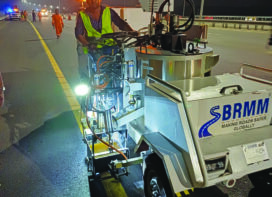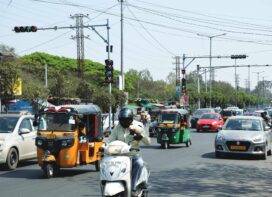 The electric vehicles (EV) market in India is set to see the entry of new players of foreign origin and home-grown start-ups in the two- and three-wheeler segments, even as the established Indian automobile firms have chosen to adopt a wait-andwatch approach before they jump onto the EV bandwagon.
The electric vehicles (EV) market in India is set to see the entry of new players of foreign origin and home-grown start-ups in the two- and three-wheeler segments, even as the established Indian automobile firms have chosen to adopt a wait-andwatch approach before they jump onto the EV bandwagon.
The government’s ambitious National Electric Mobility Mission Plan 2020 envisages achieving six-seven million sales of hybrid and electric vehicles by 2020. A series of flip-flop on policies and a nonexistent charging infrastructure are the biggest challenge in achieving the target. But is not dissuading the newer entrants. Exploring the electric vehicle landscape in India, Preeti Swaminathan takes you through the key initiatives launched by the government to promote the adoption of EVs and other sustainable mobility solutions in the country.
Realising the urgent need to re-think and revisit transport infrastructure and fuel dependency as well as the potential of EVs in doing this, the Indian government has announced plans to make the country a 100% EV nation by 2030. In line with this, in Union Budget 2018, the government allocated $40.5 million towards the development of electric and hybrid vehicles in the country. If the plans materialise, the shift to electric vehicles could potentially help India save up to $300Bn (INR 20 Lakh Cr) in oil imports and nearly one giga-tonne of carbon dioxide emissions by 2030, according to a recent report by FICCI and Rocky Mountain Institute.
India’s policy on electric vehicles
The first step taken by the Indian government to bring electricallypowered vehicles into the mainstream was the National Electric Mobility Mission Plan (NEMMP) 2020. Launched in 2013, the plan aims to achieve national fuel security by promoting hybrid and electric vehicles in the country. According to the plan, the government not only wants to reduce the country’s fuel dependency on imports but ultimately help lower greenhouse gas (GHG) emissions in India.
To this end, the Indian government and the automotive industry agreed to jointly invest up to $3.4 Bn (INR 23,000Cr) to develop a robust EV ecosystem in India. Of this, the government committed to pump up to $2.1 Bn (INR 14,000 Cr) over the next five to six years, with the remaining coming from the auto industry.
 Shailesh Chandra, President – Electric Mobility Business & Corporate Strategy, Tata Motors said, “We are optimistic about the future of Electric vehicles and intend to play a leading role in the electric mobility evolution in the country. EV products come with inherent benefits of zero emission and lower operating costs. As far as Tata Motors is concerned, we will continue to scout for opportunities to fulfil our e-mobility aspirations. We will also leverage on the capabilities of other Tata Group companies to develop the full ecosystem and fast track the adoption of e-mobility.
Shailesh Chandra, President – Electric Mobility Business & Corporate Strategy, Tata Motors said, “We are optimistic about the future of Electric vehicles and intend to play a leading role in the electric mobility evolution in the country. EV products come with inherent benefits of zero emission and lower operating costs. As far as Tata Motors is concerned, we will continue to scout for opportunities to fulfil our e-mobility aspirations. We will also leverage on the capabilities of other Tata Group companies to develop the full ecosystem and fast track the adoption of e-mobility.
With the automotive industry and government increasingly focusing on electrification of automobiles, Tata Motors has been continuously pushing the boundaries in the electric mobility space. Reiterating the company’s commitment towards smart & green technology and mobility solutions, Chandra said “we have been showcasing our products and technologies at credible auto shows both at India and International level, for over a decade now. With our understanding of the technology and customer requirements, we have bagged the order for Tigor EV, which we are supplying to EESL currently. In the Commercial vehicle category, we successfully participated in the EV bus tendering process and have won orders from six cities.”
Promotion of alternate fuels is a Government of India’s green initiative. Tata motors, are supporting this initiative to develop and launch the products with a high level of technical sophistication.”
 TML R&D center in Pune is being developed as a major facility for development work on PVs and CVs, in the field of alternate fuels. Also, organizations like IIT, IOCL and development agencies like the ARAI are working on alternate fuel products. In parallel, the focus is on for hybridization of powertrains at TML for improving fuel efficiency by way of development of PHEV/ REEV and meeting CAFE norms. Advanced Powertrain technologies as Fuel cells are at technology demonstration stage.
TML R&D center in Pune is being developed as a major facility for development work on PVs and CVs, in the field of alternate fuels. Also, organizations like IIT, IOCL and development agencies like the ARAI are working on alternate fuel products. In parallel, the focus is on for hybridization of powertrains at TML for improving fuel efficiency by way of development of PHEV/ REEV and meeting CAFE norms. Advanced Powertrain technologies as Fuel cells are at technology demonstration stage.
“It has become imperative to develop sustainable and green solutions to be used for mass transportation. Tata Starbus Hybrid Electric Bus serves this need. The 12m long bus incorporates a diesel series hybrid configuration that will significantly help reduce carbon dioxide emissions. We believe that EV space will emerge gradually, as the customers start experiencing EV products and more importantly their inherent benefits of zero emission and lower operating costs.”
Chandra cites, there are primarily two concerns when it comes to electric vehicles in India: Firstly, EV battery cost continues to be a dominant aspect of vehicle electrification. As the conventional IC powertrains are replaced by Li-Ion battery, motor and reduction drive, the cost of the propulsion system goes up significantly. This means, despite FAME incentives, the on-road price of a typical B segment car is well beyond the expectations for a retail customer, eventually limiting its penetration. Optimizing costs of the electrical drive systems and providing a commensurate payback in terms of reduced operational costs are the major challenges for OEMs including Tata Motors.
 TrafficInfraTech Magazine Linking People Places & Progress
TrafficInfraTech Magazine Linking People Places & Progress


